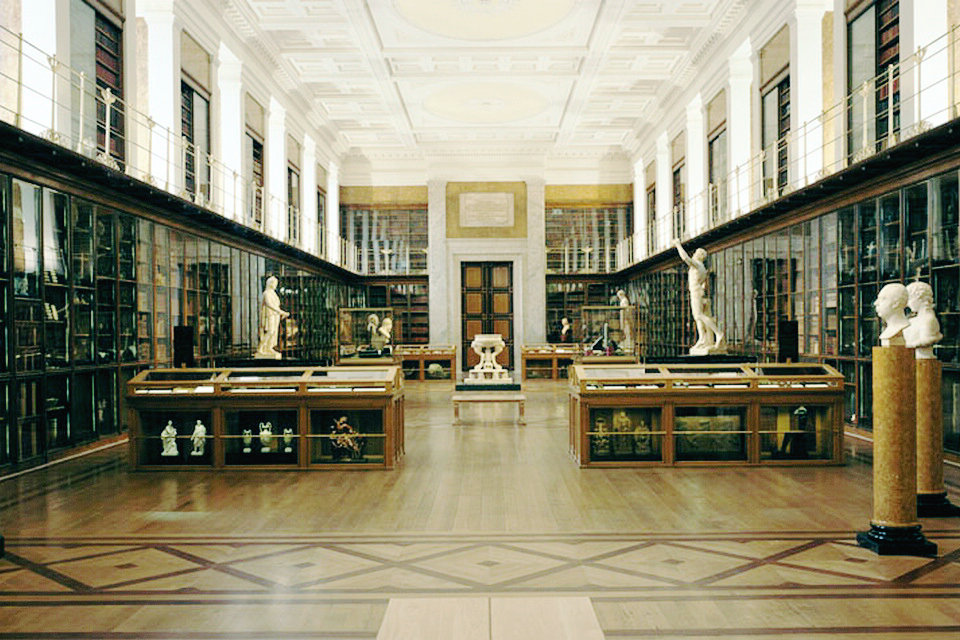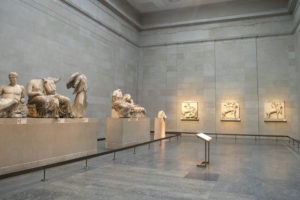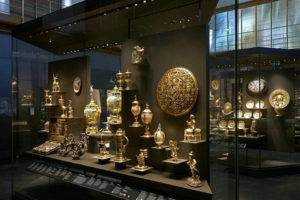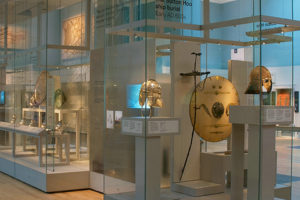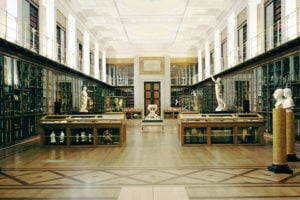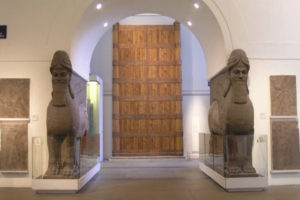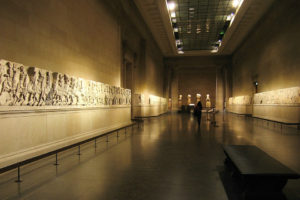Enlightenment Room of the British Museum (also know as King’s Library, Room 1), Discovering the world in the 18th century
The Enlightenment was an age of reason and learning that flourished across Europe and America from about 1680 to 1820. This rich and diverse permanent exhibition uses thousands of objects to demonstrate how people in Britain understood their world during this period. It is housed in the King’s Library, the former home of the library of King George III.
Objects on display reveal the way in which collectors, antiquaries and travellers during this great age of discovery viewed and classified objects from the world around them.
The displays provide an introduction to the Museum and its collections, showing how our understanding of the world of nature and human achievement has changed over time.
The Enlightenment Gallery is divided into seven sections that explore the seven major new disciplines of the age: Religion and ritual, Trade and discovery, the birth of archaeology, Art history, Classification, the decipherment of ancient scripts and Natural history. It was opened in 2003 to celebrate the 250th anniversary of the British Museum.
Themes in the Enlightenment Gallery
The gallery has seven sections exploring the seven major new disciplines of the age:
Religion and ritual
Christian mistrust of superstition and idols, rituals and magic had led to ignorance about other religions around the world. Scholars in the Enlightenment attempted to dispel this ignorance by studying the ancient and modern religions they encountered. They researched rituals and cults in different cultures, collected religious artefacts, grouped gods into families and examined their attributes and functions, always searching for similarities that might shed light on the origins of the world’s religions.
Trade and discovery
Sir Hans Sloane’s collection included ceremonial and every day objects representing customs and cultures of people around the globe. They formed the beginnings of an ethnographic collection that grew through the century as men like Captain James Cook and Sir Joseph Banks returned from voyages of trade and discovery to Australia, New Zealand, Tahiti and other Pacific islands.
Others were sent by the Admiralty to discover the Northwest Passage through the Arctic or by the government to forge or mend diplomatic relations. Meanwhile officials of the East India and other great trading companies studied the cultures of the people with whom they lived, collected further artefacts and published illustrated accounts that provided information about the lives and cultures of people around the world.
The Birth of Archaeology
By 1828 antiquaries were a dying breed, replaced by specialist historians and archaeologists. But for the previous two hundred years they had collected books, manuscripts, drawings and artefacts from the past, and travelled the country studying ruins in order to learn more about Britain’s early history.
It was fairly easy to learn about medieval times because more objects from those times had survived, including religious artefacts, armour, books and buildings. Antiquaries also began to survey and map Roman and earlier sites, such as Stonehenge, in a more scientific and systematic way and to learn more about the earliest Britons. This knowledge, combined with the new study of rock strata, led archaeologists to question the accepted date of the world’s creation – 4004 BC – calculated from readings of the Bible.
Art and civilisation
In 1824, Charles Townley’s famous collection of Greek and Roman sculptures, acquired on his Grand Tours in Italy, came to the British Museum. They joined the collections of prints and drawings, gems, coins, bronzes, vases and other classical antiquities that had come to the Museum from fellow connoisseurs such as Sir William Hamilton and Richard Payne Knight.
These men studied each other’s collections to learn about the ‘progress’ of art, from what they saw as its ‘primitive’ beginnings in early civilisations to what they considered to be the height of artistic achievement – the sculpture and architecture of classical Greece. This became the standard against which to measure all art and led, in eighteenth century Britain, to a classical revival in architecture and the decorative arts. Its influence can be seen here in Wedgwood’s pottery and in the Greek Revival style of the architecture of the room.
Classifying the world
The vast world of knowledge being gathered in the eighteenth century had to be classified and organized so that it could more easily understood and used. King George III’s library of nearly 70,000 books (which this room was designed to house) was encyclopaedic in its scope and arranged by subject.
The King loved medals and, as part of his library, these came to the Museum with his coin collection, all arranged by country and ruler to help bring past history alive. He was also keenly interested in the navy, navigation and scientific discoveries and collected instruments and working models.
In the early part of the century, Sir Hans Sloane had collected unusual or beautifully made instruments. His cabinets were filled with objects that aroused curiosity and they were catalogued and displayed in many different ways – by type, material, date or purpose. The ambassador to Naples, Sir William Hamilton, catalogued his vases so that they might tell the history of Greek art. The beautiful illustrations to his book inspired a wide variety of the decorative arts in Britain.
Ancient scripts
The search for knowledge about the past led to renewed interest in deciphering the mysterious forms of Egyptian hieroglyphs, the curious cuneiform inscriptions found in the lands described in the Bible, and early forms of Sanskrit in India. This increased scholarly activity eventually led to ‘cracking their codes’ in the 19th century and thousands of years of history were opened up to research. At the same time, translations were made of important books written in languages from distant lands, while nearer to home antiquaries deciphered runes and other early forms of writing, revealing more of our own history.
The Natural World
In the eighteenth century, the collections in the British Museum were divided into ‘Natural and Artificial Rarities’ – objects found in nature or made by people. Only a few rooms had man-made objects but case after case was filled with natural specimens. They included Sloane’s herbarium – albums of plants from around the world, all catalogued with a string of Latin names by his friend, the botanist John Ray.
In 1735, the Swedish botanist Carl Linnaeus revolutionised the way plants, animals and other objects from the natural world were named and classified by devising a much simpler binomial (two-name) system. His pupil, Daniel Solander, was a curator in the Museum and applied the system to Sloane’s birds, animals, shells, minerals and fossils. In 1768, he travelled with the wealthy young gentleman Joseph Banks on Captain James Cook’s first voyage to the Pacific and helped to catalogue the exotic collections they gathered there.
Many of these original specimens are included in the exhibition, as well as a number of fossils. They include one of the first dinosaurs ever found – an Ichthyosaur, discovered by Mary Anning at Lyme Regis in 1821. By 1880 there were so many natural history specimens that they needed a museum of their own – the Natural History Museum in South Kensington.
King’s Library
The King’s Library was a royal collection of books created by King George III and donated to the nation. A gallery, named after the collection, was built at the British Museum in 1827 to house them. It is the oldest room in the Museum and now home to the permanent exhibition Enlightenment: Discovering the world in the eighteenth century.
The King’s Library, a collection of over 60,000 books, was formed by King George III (1760–1820) and given to the nation in 1823 by his son King George IV.
When the library was donated there was not enough space to house it in the original British Museum building. This led to the construction of today’s quadrangle building, designed by the architect Sir Robert Smirke (1781–1867).
The room for the King’s Library was the first wing of the new building to be constructed (1823–1827). It was on a grand scale: 91m (300 feet) long, 12m (41 feet) high and 9m (30 feet) wide, with a central section 18m (58 feet) wide. Its great size called for the pioneering use of cast iron beams to support the ceiling.
Originally, it was not intended to be a public room. There were two entrances, one at either end of the room, and 12 reading desks to be used by the library assistants.
The central section of the room was meant to consist of 12 columns made from Aberdeen granite. The first four were bought, and are still in place, but the cost of polishing them was so expensive that no more were purchased.
In 1997 the books were transferred to their new home in the King’s Library Tower in the new British Library building at St Pancras, London. The books currently occupying the cases in the King’s Library are on long term loan from the House of Commons library.
Restoring the King’s Library gallery
Careful restoration work between 2000 and 2003 revived the original room to its previous glory of the 1820s, in time to celebrate the British Museum’s 250th anniversary.
Repairs to the oak and mahogany floor and classical architectural features have refreshed the space. Hundreds of square metres of plaster were cleaned to restore the yellow and gold ornamentation and the re-gilded balcony.
Two hundred kilometres of wiring (twice round the M25 motorway) enabled a subtle lighting system to be installed, which aims to complement the newly-restored colour scheme.
The result was that two centuries of use and London grime were washed away and a major permanent exhibition, using thousands of objects from the Museum collection to show how people understood their world in the Age of Enlightenment, was created.
In 2004, the King’s Library, now known as the Enlightenment Gallery, won the Crown Estate Conservation Award from the Royal Institute of British Architects. The judges said, “The restoration of the room, and its conversion to an exhibition about the history of the Enlightenment and of the early collections of the Museum itself, have revealed it in its full glory as one of the finest rooms in London.”
